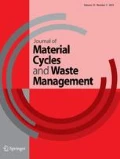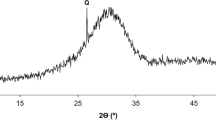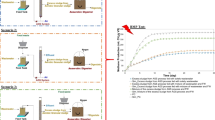Abstract
Kinetic analysis of thermally activated phase transformations in drinking water treatment plant (DWTP) sludge suggests its applicability in the materials of construction. The suggested prediction has already been verified on the sludge-based bricks. The present study deals with incorporating the same sludge in the raw meal for the synthesis of Portland cement clinkers. For this purpose, two raw meals are prepared with varying sludge loadings. The sludge effect on reactivity of the crude mixture is evaluated on the basis of the free lime content sintered at various elevated temperatures. The results of chemical and mineralogical and scanning electron microscopic analyses reveal fine mineralogical contents of Portland clinkers calcined at 1450 and 1500 °C. Moreover, the cements prepared from these clinkers by the introduction of certain proportions of gypsum, depict significant durability. The obtained results elucidate that the studied DWTP sludge-incorporated Portland cement shows considerable potential to be commercialized.











Similar content being viewed by others
References
Yano J, Shin-ichi S (2016) Waste prevention indicators and their implications from a lifecycle perspective: a review. J Mater Cycles Waste Manag 18(1):38–56. doi:10.1016/j.wasman.2015.06.012
Donatello S, Cheeseman CR (2013) Recycling and recovery routes for incinerated sewage sludge ash (ISSA): a review. Waste Manag 3(11):2328–2340. doi:10.1016/j.wasman.2013.05.024
Rodrigues LP, Holanda JNF (2015) Recycling of water treatment plant waste for production of soil cement bricks. Proced Mater Sci 8:197–202. doi:10.1016/j.mspro.2015.04.064
Benlalla A, El moussaouiti M, Dahhou M et al (2015) Utilization of water treatment plant sludge in structural ceramics bricks. Appl Clay Sci 118:171–177. doi:10.1016/j.clay.2015.09.012
Dahhou M, El Moussaouiti M, Khachani N et al (2012) Physico-chemical characterization of sludge from a unit water drinking production. Matec Web Conf. doi:10.1051/matecconf/20120201017
Lin Q, Peng H, Zhong S et al (2015) Synthesis, characterization, and secondary sludge dewatering performance of a novel combined silicon–aluminum–iron–starch flocculant. J Hazard Mater 285:199–206. doi:10.1016/j.jhazmat.2014.12.005
Zhou Z, Yang Y, Li X et al (2016) The removal characteristics of natural organic matter in the recycling of drinking water treatment sludge: role of solubilized organics. Ultrason Sonochem 28:259–268. doi:10.1016/j.ultsonch.2015.07.016
Dahhou M, El Moussaouiti M, Benlalla A et al (2016) Structural aspects and thermal degradation kinetics of water treatment plant sludge of moroccan capital. Waste Biomass Valor 7(5):1177–1187. doi:10.1007/s12649-016-9513-5
Chiang KY, Chou PH, Hua CR et al (2009) Lightweight bricks manufactured from water treatment sludge and rice husks. J Hazard Mater 171:76–82. doi:10.1016/j.jhazmat.2009.05.144
Xu GR, Zou JL, Li GB (2009) Ceramsite obtained from water and wastewater sludge and its characteristics affected by Fe2O3, CaO and MgO. J Hazard Mater 165:995–1001. doi:10.1016/j.jhazmat.2008.10.113
Toya T, Nakamura A, Kameshima Y et al (2007) Glass-ceramics prepared from sludge generated by a water purification plant. Ceram Int 33(4):573–577. doi:10.1016/j.ceramint.2005.11.009
Sotero-Santosa RB, Odete R, Povinelli J (2007) Toxicity of ferric chloride sludge to aquatic organisms. Chemosphere 68(4):628–636. doi:10.1016/j.chemosphere.2007.02.049
Bourgeois JC, Walsh ME, Gagnon GA (2004) Treatment of drinking water residuals: comparing sedimentation and dissolved air flotation performance with optimal cation ratios. Water Res 38(5):1173–1182. doi:10.1016/j.watres.2003.11.018
Liew AG, Idris A, Wong CH et al (2004) Incorporation of sewage sludge in clay brick and its characterization. Waste Manag Res 22(4):226–233. doi:10.1177/0734242X04044989
Ramadan MO, Fouad HA, Hassanain AM (2008) Reuse of water treatment plant sludge in brick manufacturing. J Appl Sci Res 4(10):1223–1229
Lin KL, Lin CY (2005) Hydration characteristics of waste sludge ash utilized as raw cement material. Cement Concr Res 35(10):1999–2007. doi:10.1016/j.cemconres.2005.06.008
Lin KL, Chiang KY, Lin CY (2005) Hydration characteristics of waste sludge ash that is reused in eco-cement clinkers. Cement Concr Res 35(6):1074–1081. doi:10.1016/j.cemconres.2004.11.014
Rodríguez NH, Martínez-Ramírez S, Blanco-Varela MT et al (2010) Re-use of drinking water treatment plant (DWTP) sludge: characterization and technological behaviour of cement mortars with atomized sludge additions. Cement Concr Res 40(5):778–786. doi:10.1016/j.cemconres.2009.11.012
Hegazy BE, Fouad HA, Hassanain AM (2012) Incorporation of water sludge, silica fume, and rice husk ash in brick making. Adv Environ Res 1:83–96. doi:10.12989/aer.2012.1.1.083
Miura K, Sato K, Suzuki T et al (2001) Thermodynamic consideration on the kiln dust generated from eco-cement production. Mater Trans 42(12):2523–2530. doi:10.2320/matertrans.42.2523
EN 196-1:2005 (E) (2005) Methods of testing cement (part 1): determination of strength [S]. British Standards Institute/The European Committee for Standardisation, Chiswick
Hasanbeigi A, Price L, Lin E (2012) Emerging energy-efficiency and CO2 emission reduction technologies for cement and concrete production: a technical review. Renew Sustain Energy Rev 16(8):6220–6238. doi:10.1016/j.rser.2012.07.019
Ghosh SN (1983) Advances in cement technology: critical reviews and case studies on manufacturing, quality control, optimization and use. Pergamon Press, Oxford
Taylor HFW (1997) Cement chemistry, 2nd edn. Thomas Telford Publishing, London
Schepper M-D, Buysser K-D, Driessche IV (2013) The regeneration of cement out of completely recyclable concrete: clinker production evaluation. Constr Build Mater 38:1001–1009. doi:10.1016/j.conbuildmat.2012.09.061
Tsakiridis PE, Oustadakis P, Agatzini-Leonardou S (2014) Black dross leached residue: an alternative raw material for portland cement clinker. Waste Biomass Valor 5(6):973–983. doi:10.1007/s12649-014-9313-8
Vilaplana AS-D-G, Ferreira VJ, López-Sabirón AM (2015) Utilization of ladle furnace slag from a steelwork for laboratory scale production of portland cement. Constr Build Mater 94:837–843. doi:10.1016/j.conbuildmat.2015.07.075
Lam CHK, Barford JP, McKay G et al (2011) Utilization of municipal solid waste incineration ash in portland. Clean Tech Environ Policy 13(4):607–615. doi:10.1007/s10098-011-0367-z
Wang FZ, Shang DC, Wang MG et al (2016) Incorporation and substitution mechanism of cadmium in cement clinker. J Clean Prod 112:2292–2299. doi:10.1016/j.jclepro.2015.09.127
Stutzman P, Heckert A, Tebbe A et al (2014) Uncertainty in Bogue-calculated phase composition of hydraulic cements. Cement Concr Res 61–62:40–48. doi:10.1016/j.cemconres.2014.03.007
Hewlett PC (1998) Lea’s chemistry of cement and concrete, 4th edn. Elsevier Butterworth-Heinemann, Oxford
Vangelatos I, Angelopoulos GN, Boufounos D (2009) Utilization of ferroalumina as aw material in the production of ordinary portland cement. J Hazard Mater 168(1):473–478. doi:10.1016/j.jhazmat.2009.02.049
Kakali G, Tsivilis S, Kolovos K et al (2003) Use of secondary mineralizing raw materials in cement production. The case study of a stibnite ore. Mater Lett 57(20):3117–3123. doi:10.1016/S0167-577X(03)00007-7
Stephan D, Wistuba S (2006) Crystal structure refinement and hydration behaviour of 3CaO·SiO2 solid solutions with MgO, Al2O3 and Fe2O3. J Eur Ceram Soc 26:141–148. doi:10.1016/j.jeurceramsoc.2004.10.031
Dunstetter F, Noirfontaine MN, Courtial M (2006) Polymorphism of tricalcium silicate, the major compound of portland cement clinker: structural data: review and unified analysis. Cement Concr Res 36(1):39–53. doi:10.1016/j.cemconres.2004.12.003
Opoczky L, Gavel V (2004) Effect of certain trace elements on the grindability of cement clinkers in the connection with the use of wastes. Int J Miner Process 74S:S129–S136. doi:10.1016/j.minpro.2004.07.020
Tsurumi T, Hirano Y, Kato H et al (1994) Crystal structure and hydration of belite. Ceram Trans 40:19–25
Mondal P, Jefferey JW (1975) The crystal structure of tricalcium aluminate, Ca3Al2O6. Acta Cryst B 31:17–30
Kacimi L, Simon-Masseron A, Salem S et al (2009) Synthesis of belite cement clinker of high hydraulic reactivity. Cement Concr Res 39(7):559–565. doi:10.1016/j.cemconres.2009.02.004
Hong H, Fu Z, Min X (2001) Effect of cooling performance on the mineralogical character of portland cement clinker. Cement Concr Res 31(2):287–290. doi:10.1016/S0008-8846(00)00445-2
Kacimi L, Simon-Masseron A, Ghomari A et al (2006) Influence of NaF, KF and CaF2 addition on the clinker burning temperature and its properties. CR Chimie 9(1):154–163. doi:10.1016/j.crci.2005.10.001
AENOR EN 197–1 (2000) Cement composition, specifications and conformity criteria for common cements. European Standard
Atmaca A, Kanoglu M (2012) Reducing energy consumption of a raw mill in cement industry. Energy 42:261–269. doi:10.1016/j.energy.2012.03.060
Madlool NA, Saidur R, Hossain MS et al (2011) A critical review on energy use and savings in the cement industries. Renew Sustain Energy Rev 15:2042–2060. doi:10.1016/j.rser.2011.01.005
Li H, Zhao J, Huang Jiang Z et al (2016) Investigation on the potential of waste cooking oil as a grinding aid in portland cement. J Environ Manag 184:545–551. doi:10.1016/j.jenvman.2016.10.027
Acknowledgements
The authors acknowledge support from “National Office of electricity and drinking water” (ONEE) for supplying drinking water sludge.
Author information
Authors and Affiliations
Corresponding authors
Annex
Annex
Drinking water treatment plant (DWTP) sludge Drinking water treatment plant sludge is a semi-solid slurry produced from conventional drinking water treatment. It is a mixture of water and solids (mainly alumina and silica) separated by decantation and filtration processes during the treatment of drinking water.
Clinker Clinker is a mixture of raw meals, which comprises limestone and silico-aluminate source calcined at 1450–1500 °C.
Cement In the clinker consisting of ground fine particles, addition of 3% gypsum generates a mixture, called Portland cement.
Rights and permissions
About this article
Cite this article
Dahhou, M., El Moussaouiti, M., Arshad, M.A. et al. Synthesis and characterization of drinking water treatment plant sludge-incorporated Portland cement. J Mater Cycles Waste Manag 20, 891–901 (2018). https://doi.org/10.1007/s10163-017-0650-0
Received:
Accepted:
Published:
Issue Date:
DOI: https://doi.org/10.1007/s10163-017-0650-0




